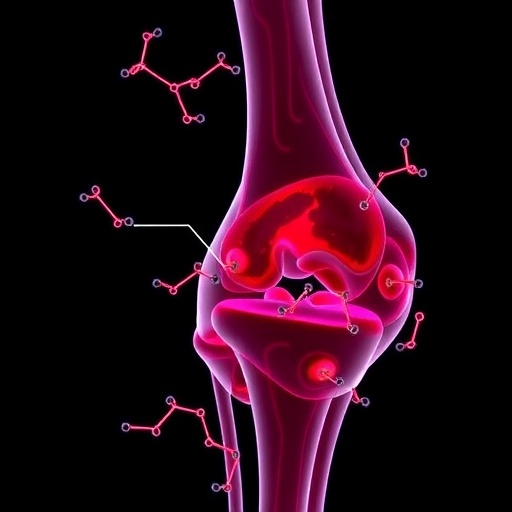Diabetes specialist Rita Kalyani outlines the current standards of care for diabetes management

Credit: Johns Hopkins Medicine
New medicines for people who have diabetes seem to pop up all the time. Drugs that help the body break down carbohydrates, drugs that increase excretion of glucose in the urine, drugs that help muscles respond to insulin and drugs that stimulate the pancreas to produce it — the list of pharmaceutical options to treat diabetes gets longer and longer.
The downside of this wealth of treatment options is that it can be difficult for health care providers to stay on top of the latest research and standards of care. Which medication is best for which patients? And what are the best medicines to prescribe that both lower blood glucose and reduce risk for cardiovascular disease?
Johns Hopkins Medicine endocrinologist and associate professor Rita Rastogi Kalyani, M.D., authored a clinical practice review article in the April 1 edition of The New England Journal of Medicine (NEJM) that distills the newest trial results and guidelines into a systematic approach for treating patients with diabetes and a risk of cardiovascular disease. Kalyani’s article is the first clinical practice review that the journal has published on diabetes management in almost a decade.
Different from research studies, clinical practice reviews present a common clinical problem and the evidence supporting various treatment strategies, followed by a review of the guidelines and the author’s clinical recommendations to optimize patient care.
People who have type 2 diabetes are more than twice as likely to develop atherosclerotic cardiovascular disease and heart failure than people who don’t have the disease. The NEJM article presents an up-to-date approach for health care providers when choosing among glucose-lowering therapies for their patients with diabetes, particularly to reduce the risk of cardiovascular disease.
“We’ve seen a major shift in diabetes care over the past few years,” says Kalyani. “We now have tools to better understand how to reduce both microvascular and macrovascular complications in people with type 2 diabetes.”
The article examines the cardiovascular benefits and risks of the most commonly used drugs for diabetes that are currently available on the U.S. market.
Kalyani lists specific agents in two newer drug classes as beneficial for patients with diabetes who already show signs of heart or blood vessel disease.
The glucagon-like peptide 1 (GLP-1) receptor agonists liraglutide, injectable semaglutide and dulaglutide increase insulin production from the body, particularly after meals.
Sodium glucose cotransporter 2 (SGLT2) inhibitors empagliflozin and canagliflozin reduce the amount of glucose the body re-absorbs through urine.
All are effective at helping patients reduce the chance of having a major cardiovascular event, such as heart attack or stroke. The SGLT2 inhibitor, dapagliflozin, is effective at helping reduce the chance of hospitalization for heart failure.
“After metformin, which is widely considered the initial drug treatment for type 2 diabetes, specific drugs in the GLP-1 receptor agonist and SGLT2 inhibitor classes with demonstrated cardiovascular benefit should be considered as additional medications for patients who already have cardiovascular disease. This should be done irrespective of whether their A1C level is at target to reduce the risk of future cardiovascular events,” says Kalyani, referring to the hemaglobin A1C test, which measures a patient’s average blood glucose level over three months.
Sugar attaches to a protein in red blood cells that carries oxygen to organs and tissue and that transports carbon dioxide to the lungs. The A1C test measures the average percentage of glucose in a person’s hemoglobin over the span of several months. Healthy A1C levels are below 5.7%. Generally, A1C levels higher than 6.5% indicate diabetes.
Kalyani notes that the newer drugs tend to be more expensive, and long-term effects are unknown. Before 2008, the U.S. Food and Drug Administration the agency that regulates the pharmaceutical industry — did not require large outcome trials for drugs after their introduction to the market. As a result, says Kalyani, the cardiovascular effects of older drugs remain less certain.
The NEJM article details specific drugs that offer additional benefits for patients with diabetes who have conditions such as multiple cardiovascular disease risk factors, heart failure and chronic kidney disease.
“Some agents such as dulaglutide and dapagliflozin also have demonstrated cardiovascular benefit in patients with multiple cardiovascular risk factors,” Kalyani says.
Further, specific SGLT2 inhibitors can be beneficial for patients who have heart failure with reduced ejection fraction — a condition in which the heart muscle doesn’t pump blood efficiently — as well for patients with chronic kidney disease.
The article includes comprehensive drug tables that include the factors to consider in clinical practice when choosing a glucose-lowering drug for patients with type 2 diabetes, including A1C-lowering efficacy, route and frequency of administration, cost, effects on weight, risk of hypoglycemia, side effects and clinical benefits.
“Health care providers in primary care, endocrinology, cardiology and nephrology are now prescribing these newer glucose-lowering drugs for their patients,” Kalyani says. “Diabetes care will need to be increasingly collaborative in the future and, at its core, remain patient-centered.”
###
Kalyani was previously the chair of the American Diabetes Association’s Professional Practice Committee, which annually updates the Standards of Medical Care in Diabetes, the organization’s clinical practice recommendations. She has also co-authored clinical guidelines published by the Endocrine Society and the American College of Cardiology.
The author reports no industry conflicts.
Media Contact
Patrick Smith
[email protected]
Original Source
https:/




